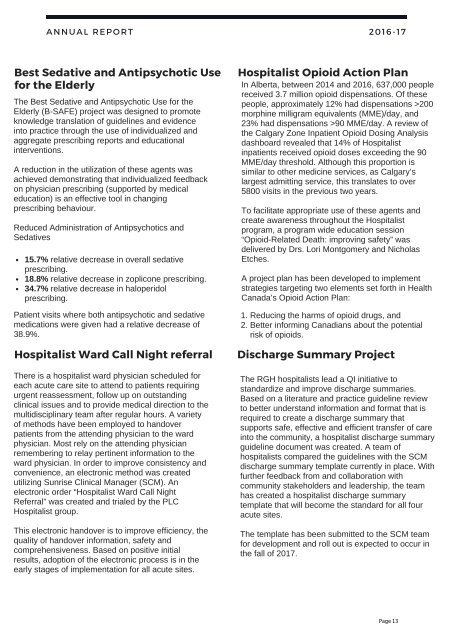DFM 2016-2017 Annual Report
2016-2017 Annual Report from the Department of Family Medicine, Calgary.
2016-2017 Annual Report from the Department of Family Medicine, Calgary.
- No tags were found...
Create successful ePaper yourself
Turn your PDF publications into a flip-book with our unique Google optimized e-Paper software.
A N N U A L R E P O R T 2 0 1 6 - 1 7<br />
Sedative and Antipsychotic Use<br />
Best<br />
the Elderly<br />
for<br />
The Best Sedative and Antipsychotic Use for the<br />
Elderly (B-SAFE) project was designed to promote<br />
knowledge translation of guidelines and evidence<br />
into practice through the use of individualized and<br />
aggregate prescribing reports and educational<br />
interventions.<br />
A reduction in the utilization of these agents was<br />
achieved demonstrating that individualized feedback<br />
on physician prescribing (supported by medical<br />
education) is an effective tool in changing<br />
prescribing behaviour.<br />
Reduced Administration of Antipsychotics and<br />
Sedatives<br />
15.7% relative decrease in overall sedative<br />
prescribing.<br />
18.8% relative decrease in zoplicone prescribing.<br />
34.7% relative decrease in haloperidol<br />
prescribing.<br />
Patient visits where both antipsychotic and sedative<br />
medications were given had a relative decrease of<br />
38.9%.<br />
Opioid Action Plan<br />
Hospitalist<br />
In Alberta, between 2014 and <strong>2016</strong>, 637,000 people<br />
received 3.7 million opioid dispensations. Of these<br />
people, approximately 12% had dispensations >200<br />
morphine milligram equivalents (MME)/day, and<br />
23% had dispensations >90 MME/day. A review of<br />
the Calgary Zone Inpatient Opioid Dosing Analysis<br />
dashboard revealed that 14% of Hospitalist<br />
inpatients received opioid doses exceeding the 90<br />
MME/day threshold. Although this proportion is<br />
similar to other medicine services, as Calgary’s<br />
largest admitting service, this translates to over<br />
5800 visits in the previous two years.<br />
To facilitate appropriate use of these agents and<br />
create awareness throughout the Hospitalist<br />
program, a program wide education session<br />
“Opioid-Related Death: improving safety” was<br />
delivered by Drs. Lori Montgomery and Nicholas<br />
Etches.<br />
A project plan has been developed to implement<br />
strategies targeting two elements set forth in Health<br />
Canada’s Opioid Action Plan:<br />
1. Reducing the harms of opioid drugs, and<br />
2. Better informing Canadians about the potential<br />
risk of opioids.<br />
Discharge Summary Project<br />
Ward Call Night referral<br />
Hospitalist<br />
There is a hospitalist ward physician scheduled for<br />
each acute care site to attend to patients requiring<br />
urgent reassessment, follow up on outstanding<br />
clinical issues and to provide medical direction to the<br />
multidisciplinary team after regular hours. A variety<br />
of methods have been employed to handover<br />
patients from the attending physician to the ward<br />
physician. Most rely on the attending physician<br />
remembering to relay pertinent information to the<br />
ward physician. In order to improve consistency and<br />
convenience, an electronic method was created<br />
utilizing Sunrise Clinical Manager (SCM). An<br />
electronic order “Hospitalist Ward Call Night<br />
Referral” was created and trialed by the PLC<br />
Hospitalist group.<br />
This electronic handover is to improve efficiency, the<br />
quality of handover information, safety and<br />
comprehensiveness. Based on positive initial<br />
results, adoption of the electronic process is in the<br />
early stages of implementation for all acute sites.<br />
The RGH hospitalists lead a QI initiative to<br />
standardize and improve discharge summaries.<br />
Based on a literature and practice guideline review<br />
to better understand information and format that is<br />
required to create a discharge summary that<br />
supports safe, effective and efficient transfer of care<br />
into the community, a hospitalist discharge summary<br />
guideline document was created. A team of<br />
hospitalists compared the guidelines with the SCM<br />
discharge summary template currently in place. With<br />
further feedback from and collaboration with<br />
community stakeholders and leadership, the team<br />
has created a hospitalist discharge summary<br />
template that will become the standard for all four<br />
acute sites.<br />
The template has been submitted to the SCM team<br />
for development and roll out is expected to occur in<br />
the fall of <strong>2017</strong>.<br />
Page 13


